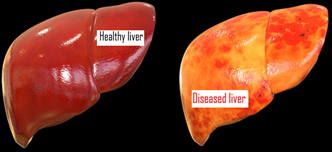Fatty liver is a commonly heard word these days among people those who do an annual health check because an ultrasound of the abdomen is also usually done. An estimated 20 to 40% of the population has some degree of fatty liver, and hence an ultrasound of the abdomen must be done.
Liver is the largest organ in the body. It helps to digest food, store energy, and remove toxins (poisons). Fatty liver is a condition in which fat builds up in the liver. If liver fails to function, the body fails; hence it is necessary that liver health gets due attention.
Fatty liver is classified as:
- AFLD (Alcoholic Fatty Liver Disease)
- NAFLD (Non-alcoholic Fatty Liver Disease)
NAFLD is further divided into two groups:
- NAFL (Non-alcoholic Fatty Liver) or simple fatty liver
- NASH (Non-alcoholic Steatohepatitis)
AFLD is due to heavy alcohol use. More the alcohol intake greater is the liver damage. Alcoholic fatty liver disease is the earliest stage of alcohol-related liver disease, followed by alcoholic hepatitis and cirrhosis.
Should you be concerned if your ultrasound shows evidence of fatty liver?
The answer is yes…here’s why. For most people simple fatty liver doesn’t cause sickness related to liver but those with NASH injury to liver cells is found that increases the risk of progression to fibrosis (scarring) of liver, cirrhosis and liver cancer. In fact, NASH cirrhosis is expected to be number one reason for liver transplant in the coming years. NASH affects 3% to 7% of US population while most people with NAFLD have simple fatty liver.
The other reason for concern is that NAFLD is associated with diabetes and obesity. It is also linked to increased risk of heart disease.
Yet, understanding NAFLD is still work in progress!
No opportunity should be lost to counsel and follow up employees showing evidence of fatty liver and a specialist’s opinion sought as appropriate.
Cause of NAFLD is not known, yet some common risks factors are:
- Type-2 diabetes and prediabetes
- Obesity
- Middle age or older (although children also get it)
- Have high levels of fats in the blood (cholesterol, triglycerides)
- High blood pressure
- Certain drugs, such as corticosteroids and some cancer drugs
- Rapid weight loss
- Infections, such as hepatitis C
- Exposure to some toxins
To find if a person has simple fatty liver or NASH, a liver biopsy is required. Since it is impractical to do a liver biopsy for everyone, research is on to find out non-invasive ways to identify who is at the greatest risk of developing fibrosis.
Some non-invasive approaches include biomarkers and scoring system based on blood tests (NAFLD fibrosis score and Fibrosis-4 index. Elastography (a technique that uses soundwaves to estimate fibrosis based on stiffness of the liver) also helps.
If diagnosed with fatty liver, it should be your aim to keep the liver healthy by:
- Avoiding alcohol
- Taking medicines only after checking with your doctor as many of them are harmful (example, some medicines used to reduce fever or treat common cold could be harmful)
- Vaccinate yourself against viruses that cause Hepatitis (A & B)
- Checking with your doctor if you have any underlying or treatable disease contributing to your fatty liver
- Regularly screen yourself for liver cancer if you already have cirrhosis
Medical treatment: As of now there are no medications approved by FDA for fatty liver. However, American Association for Study of Liver Disease affirms two drugs for biopsy-proven NASH, namely, Vitamin E and pioglitazone (used to treat diabetes). The two drugs are not for everyone, and your doctor will decide if you would benefit from them.
There are more drugs in the pipeline, some with promising initial study results. If everything fails and the disease progresses, then a liver transplant is an option.
Lifestyle changes as below are the most effective treatment for fatty liver:
- Lose weight: Losing 5% of your body weight usually improves abnormal liver tests and decreases the fat in the liver. Losing between 7% and 10% of body weight seems to decrease the amount of inflammation and injury to liver cells, and it may even reverse some of the damage of fibrosis. Lose ½ to 1 kilogram per week, as very rapid weight loss may worsen inflammation and fibrosis. Consider weight loss surgery with your doctor, if you aren’t losing much weight.
- Exercise: Leads to decreased fat in the liver.
- Diet: Include fruits, vegetables, whole grains, legumes, and nuts. Replace butter with olive or canola oil, limiting red meat, and eating more fish and lean poultry.
- Coffee: Some studies showed that patients with NAFLD who drank coffee (about two cups every day) had a decreased risk in fibrosis.
If you have fatty liver, your biggest risk is still cardiovascular disease, and hence lifestyle changes not only improve fatty liver, but also help keep your heart healthy.
About 1 in 5 people (20%) with NAFLD go on to develop NASH. And 1 in 5 of those people who have NASH go on to develop cirrhosis. Hence it is important to speak to your doctor if you think you may be at any stage of NAFLD or have any concerns about your liver health.
That means in a company employing 1000 employees there is a possibility that around 200 of them have fatty liver of which around 70 will have NASH and 14 will develop cirrhosis. Early advice, lifestyle changes and interventions, if any, can delay progress of fatty liver to cirrhosis or liver cancers.
In an industrial or corporate setup, the working population usually undergoes annual health checks. Although fatty liver is not an occupational (work-related) illness, no opportunity should be lost to counsel and follow up employees showing evidence of fatty liver and a specialist’s opinion sought as appropriate.
The OH physician attached to an industry should highlight to the management about risks of employees having fatty liver.
Just as heavy industries have hearing conservation program to protect employees from hearing loss due to high noise, it is a good idea to consider having a fatty liver program as a wellness initiative to identify and prevent or delay complications of NAFLD, especially NASH.
For those on their own, it is advisable to do annual health checks that includes an ultrasound of the abdomen to pick up any early evidence of fatty liver and consult a physician.
Interestingly, looking after your liver health will also improve your heart health as both require lifestyle changes!
For more info, contact
_________________________________________________________________________________________________________
Dr Ajay Sati is an Occupational Health physician who prefers to describe himself as an Occupationist, to denote, ‘an expert in diseases and other concerns of occupations’. Dr Sati has managed health and wellness programs in industries he worked, like the atomic energy, and energy (oil & gas) in India and overseas. He was involved in many greenfield and brownfield projects providing inputs from health point of view. Known for SOPs and protocols, he is currently involved with an energy MNC in designing protocols to support employees during the covid pandemic, and protocols to safely reopen offices and plants.



